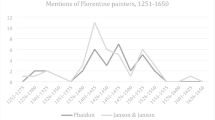Summary
As is the case with other field theories, Urban Economics, Environmental Economics, etc. the microeconomics of the arts attempts to derive a set of particular propositions from the general propositions of Economic Theory. In the process a substantial amount of cross-fertilization takes place. The specific characteristics of art markets require modification or amplification of some general propositions of economic theory, which in turn may offer novel and possibly useful insights as well as testable hypotheses. The following propositions appear to emanate from the present paper.
In general markets R & D efforts are directed towards product or process innovation. For the most part, a known consumer technology exists. Innovation in art markets involves product creation as well as the creation of a consumer technology capable of deriving satisfaction from consumption of the new product. In open markets, a non-patentable product would entail excessive free ridership. Such a state of affairs may discourage innovation. Primary sellers would tend to adapt to narrowly changing consumer technologies. Such was the case during most of art history up to the late 19th century. At present, museums and art critics act as quasi patent offices, which fosters innovation by assuring a positive sum game.
A new consumer technology is expected to be demand-augmenting. Not necessarily in the sence of McCain [12] where discontinuous jumps in demand are postulated. Even if such shifts were to occur in individual demand curves, market demand will nevertheless be continuous. The present model presumes that the augmentation is mostly due to increasing numbers of art buyers entering as the new consumer technology casues substitution of one style for another (or one fad for another). Syndicate behavior is induced by the winners of the race who have successfully established a new consumer technology and subsequently extend an umbrella over the membership. In this manner the spoils are shared more equitably. This is a peculiarly modern phenomenon. In the past one could not put a Teniers above a Rembrandt or a Polidoro above a Raphael. The generally accepted rules of decorativeness, that is, craftmanship and composition were obvious and immediately perceptible by all.
In certain instances syndicate behavior favors single leadership by an established dealer, or a small group of dealers with a proven track record in spawning new technologies. Collectors, too, are involved, by overpaying for art. The discovering collector creates entry barriers for other collectors and thus has a monopoly of discovery of purely “intellectual appeal” art. Followers may opt to reduce their rivalry in exchange for assurances that once the new technology is in place, they will be given the opportunity to recycle the art brought into being by the leader or leaders. Under certain conditions, as analyzed in the foregoing, this constitutes an optimal strategy.
As in the classical case, entry reduces investment and drives rents to zero, if each firm invests a roughly equivalent amount in support of the prevailing consumer technology. There arises the limiting case, equivalent to pure competition (see EQ. 10). On the other hand, several counterveiling strategies are possible. For example, overpayment, as in the case of Rothko. This limits the artists' output in the market. Leftover art is donated or acquired by museums. Such art is no longer competitive, as opposed to art held by other collectors, which, diminishes art'sscarcity value.
The most probable outcome of a Cournot-Stackelberg type behavior is a succession of leader-follower or leader-recyler type syndicates, each successively dissolving as new consumer technologies replace old ones. It is, of course, possible for several specialized syndicates to operate contemporaneously. The rate of turnover clearly depends on the speed of dissemination of information. The curator, critic, trustee, consultant has a vested interest in episodic art and an spawning new consumer technologies: if this were not so, there would be no need for the pre-eminance of the critic. He is the magician, the priest, the medicine man who “knows” the secret language and penetrates the mysteries.
Similar content being viewed by others
References
Leslie Singer, “Microeconomics of the Art Market,”Journal of Cultural Economics, 2, 1978, pp. 21–39. “Supply Decisions of Professional Artists,”American Economic Review, 71, 1981, pp. 341–346.
John L. Hess,The Grand Acquisitors, New York: Houghton Mifflin, 1974, p. 97.
Judity Zilczer, “The Noble Buyer:” John Quinn, Patron of the Avant-Garde, Washington, D.C., The Smithsonian Institution Press, 1978, also Archives of American Art in the Smithsonian Institution and Manuscripts and Archives Astor, Lenox and Tilden Foundation, New York Public Library.
Hess,Ibid. p. 96.
Art & Auction 4, 1981, pp. 52,53.
Jack Hirshleifer “The Private and Social Value of Information and The Reward to Inventive Activity,“American Economic Review, 61, 1971, pp. 561–574.
Tom Lee and Louis L. Wilde, “Market Structure and Innovation: A Reformulation,”Quarterly Journal of Economics, 44, 1980, p. 431.
M. Kamien and N. Schwartz, “Timing of Innovations Under Rivalry,”Econometrica, 40, 1972, pp. 43–59 and “On the Degree of Rivalry for Maximum Innovative Activity,”Quarterly Journal of Economics, 40, 1976, pp. 245–60.
Malborough records and Hess, Ibid., 116-119, also Jacob Kainen's testimony in Rothko estate hearings.
M. Okuno, A. Postlewaite and F. Roberts, “Oligopoly and Competition in Large Markets,”American Economic Review, 70, 1980, pp. 22–31.
P.L. Swan, “Alcoa: The Influence of Recycling on Monopoly Power,”Journal of Political Economy, 88, 1980, pp. 76–99.
Roger A. McCain, “Reflections on the Cultivation of Taste,”Journal of Cultural Economics. 3, 1979, pp. 30–52, also,American Economic Review, 71, 1978, pp. 332–334.
Author information
Authors and Affiliations
Rights and permissions
About this article
Cite this article
Singer, L.P. Rivalry and externalities in secondary art markets. J Cult Econ 5, 39–57 (1981). https://doi.org/10.1007/BF02221369
Issue Date:
DOI: https://doi.org/10.1007/BF02221369




